TALK ASTRODOME TOMORROW WITH THE GUYS THAT WROTE THE BOOK ON IT 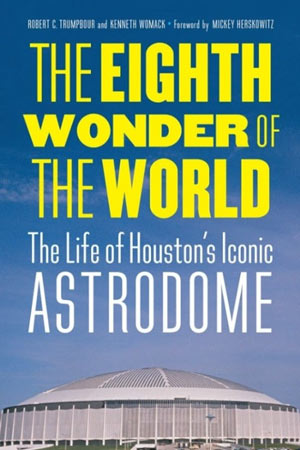 There’s a new tell-all biography of the Astrodome out this fall, now that year 50 since the stadium’s mid-1965 opening has wrapped up. Robert C. Trumpbour and Kenneth Womack’s The Eighth Wonder of the World: The Life of Houston’s Iconic Astrodome covers Dome history from its development days, and gets into how the building shaped Houston and Houston’s reputation. The authors, one of whom has also written another book about stadium construction politics, will be in town tomorrow night for a free talk and book signing — you can check out the when-and-where and RSVP here. The book includes what University of Nebraska Press refers to as some of the structure’s more “memorable problems, such as outfielders’ inability to see fly balls and failed attempts to grow natural grass — which ultimately led to the development of Astroturf.” The text also touches on some of the most recent will-they-won’t-they preservation scuffles— though its publication date precedes this year’s approval by Harris County of initial funding for that plan to turn the bottom levels of the stadium into a parking garage.  [University of Nebraska Press] Image of book cover: University of Nebraska Press
There’s a new tell-all biography of the Astrodome out this fall, now that year 50 since the stadium’s mid-1965 opening has wrapped up. Robert C. Trumpbour and Kenneth Womack’s The Eighth Wonder of the World: The Life of Houston’s Iconic Astrodome covers Dome history from its development days, and gets into how the building shaped Houston and Houston’s reputation. The authors, one of whom has also written another book about stadium construction politics, will be in town tomorrow night for a free talk and book signing — you can check out the when-and-where and RSVP here. The book includes what University of Nebraska Press refers to as some of the structure’s more “memorable problems, such as outfielders’ inability to see fly balls and failed attempts to grow natural grass — which ultimately led to the development of Astroturf.” The text also touches on some of the most recent will-they-won’t-they preservation scuffles— though its publication date precedes this year’s approval by Harris County of initial funding for that plan to turn the bottom levels of the stadium into a parking garage.  [University of Nebraska Press] Image of book cover: University of Nebraska Press
Tag: Houston History
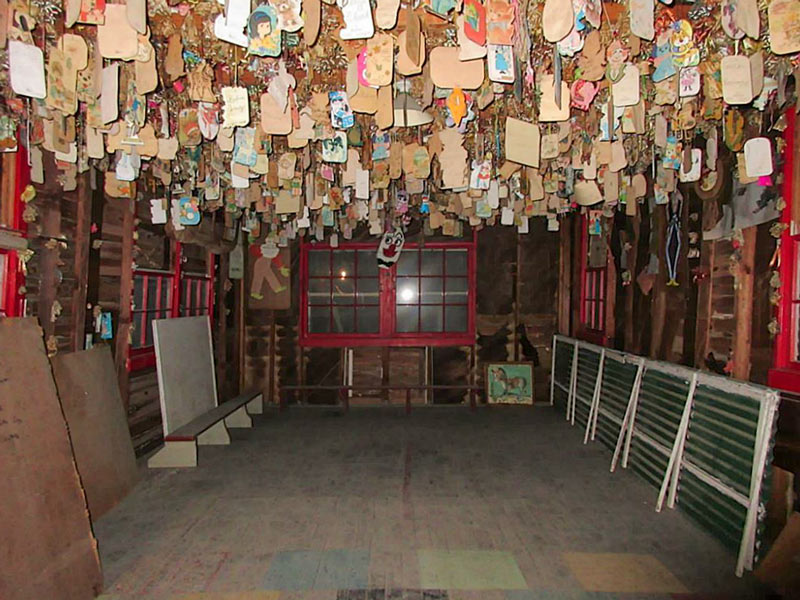
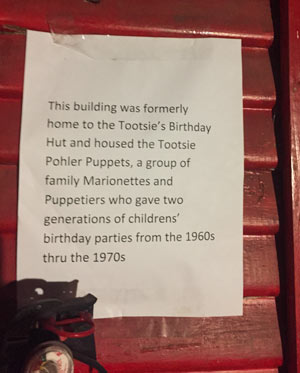 A few readers were curious about the detached backyard room densely strewn with drawings of clowns and other cartoonish figures that made an appearance as Swamplot’s Home Listing Photo of the Day late last month. If you were waiting for more info on the property to make an offer, you’re too late — the place is already listed as under contract, along with the interior furnishings. Here’s a few more shots of the leftover memorabilia in the space, formerly known as Tootsie’s Birthday Hut:
A few readers were curious about the detached backyard room densely strewn with drawings of clowns and other cartoonish figures that made an appearance as Swamplot’s Home Listing Photo of the Day late last month. If you were waiting for more info on the property to make an offer, you’re too late — the place is already listed as under contract, along with the interior furnishings. Here’s a few more shots of the leftover memorabilia in the space, formerly known as Tootsie’s Birthday Hut:
A BRIEF HISTORY OF HOUSTON’S FUTURE HISTORIC PRESERVATION CULTURE 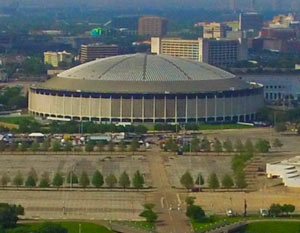 “Houston seems younger than it is,” writes Barry Moore today: “Few would guess that our founding by the Allen Brothers was within a few years of Chicago’s. Why does Chicago seem so much older? The answer is complex.” While the 70-year-old annual conference of the National Trust for Historic Preservation kicks off today in Houston for the first time, Moore charts decades of change in Houston’s laws, tax rules, and attitudes related to letting historic structures and places stick around. And Moore claims that these days, Houston’s out-with-the-old reputation “is itself a relic. Houston has turned a corner. After half a century of organizing, we now have a preservation culture and laws to protect parts of the built environment. This may be hard to believe, but I will argue that no other city in the country has such an opportunity to become ground zero for the future of the preservation movement.” [OffCite; previously on Swamplot] Photo of Astrodome: Russell Hancock via Swamplot Flickr Pool
“Houston seems younger than it is,” writes Barry Moore today: “Few would guess that our founding by the Allen Brothers was within a few years of Chicago’s. Why does Chicago seem so much older? The answer is complex.” While the 70-year-old annual conference of the National Trust for Historic Preservation kicks off today in Houston for the first time, Moore charts decades of change in Houston’s laws, tax rules, and attitudes related to letting historic structures and places stick around. And Moore claims that these days, Houston’s out-with-the-old reputation “is itself a relic. Houston has turned a corner. After half a century of organizing, we now have a preservation culture and laws to protect parts of the built environment. This may be hard to believe, but I will argue that no other city in the country has such an opportunity to become ground zero for the future of the preservation movement.” [OffCite; previously on Swamplot] Photo of Astrodome: Russell Hancock via Swamplot Flickr Pool
NATIONAL HISTORIC PRESERVATIONISTS TO GATHER IN HOUSTON, GAWK AT ASTRODOME  The National Trust for Historic Preservation — that’d be the folks that coined the ‘orgy of irrational destruction’ line picked up by Save the Bungalows a few years back — is holding its annual conference in Houston for the first time, starting next Tuesday. Current president Stephanie Meeks cites the city’s “compelling preservation story,” amid a regional lack of preservation-minded rules and regulations, as a reason for picking the city. Planned field trip locales include the Astrodome (currently getting ready for that basement parking garage remodel), as well as Mission Control, the artsifying warehouses and industrial facilities around Washington Ave., and a handful of Galveston historic districts. Also on the docket: the debut of the organization’s Atlas of ReUrbanism (a digital collection of built environment data aimed public officials, reporters, and other city data scavengers), for which Houston is one of 5 starter cities. Would-be attendees can catch some conference sessions next Tuesday through Friday in the neighborhood of the newly-game-faced George R. Brown Convention Center; those who don’t want to make the trip downtown can watch some sessions at home. [Previously on Swamplot] Photo of Astrodome: Russell Hancock via Swamplot Flickr Pool
The National Trust for Historic Preservation — that’d be the folks that coined the ‘orgy of irrational destruction’ line picked up by Save the Bungalows a few years back — is holding its annual conference in Houston for the first time, starting next Tuesday. Current president Stephanie Meeks cites the city’s “compelling preservation story,” amid a regional lack of preservation-minded rules and regulations, as a reason for picking the city. Planned field trip locales include the Astrodome (currently getting ready for that basement parking garage remodel), as well as Mission Control, the artsifying warehouses and industrial facilities around Washington Ave., and a handful of Galveston historic districts. Also on the docket: the debut of the organization’s Atlas of ReUrbanism (a digital collection of built environment data aimed public officials, reporters, and other city data scavengers), for which Houston is one of 5 starter cities. Would-be attendees can catch some conference sessions next Tuesday through Friday in the neighborhood of the newly-game-faced George R. Brown Convention Center; those who don’t want to make the trip downtown can watch some sessions at home. [Previously on Swamplot] Photo of Astrodome: Russell Hancock via Swamplot Flickr Pool
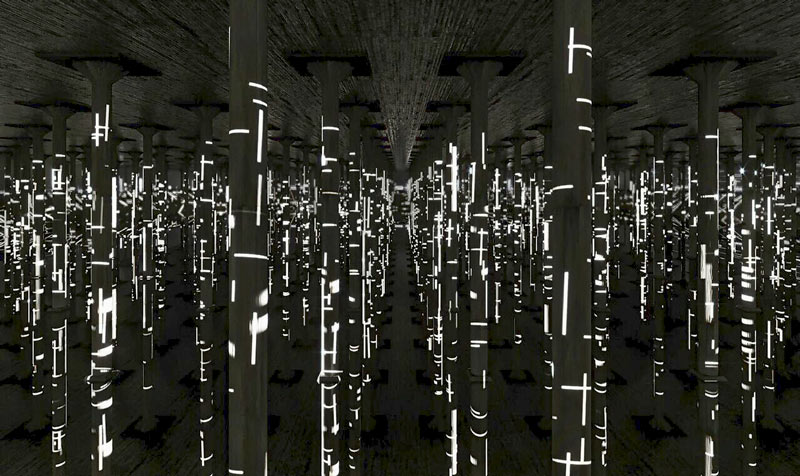
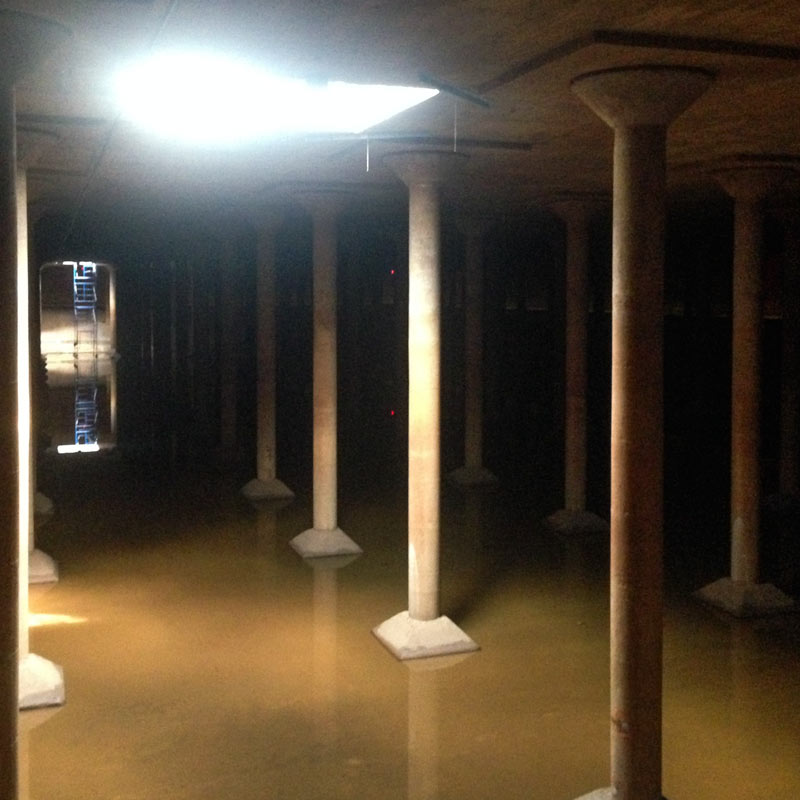 The rendering up top shows the sort of scene that visitors can expect if they wander into the 1920’s leaking-water-reservoir-turned-public-art-space buried alongside Buffalo Bayou after December 10th (and before next June): Venezuelan artist Magdalena Fernández’s 2iPM009 projection, adapted from flat-walled origins to fill the 2-acre space (and going by the name Rain). As for what they’ll hear — that’d be an accompanying soundtrack of snaps, claps, and other meteorologically-inspired noisemaking from Slovenian choir Pertuum Jazzile. The original piece is part of the Museum of Fine Arts’s permanent collection; the adaptation will be the first temporary art installation in the column-studded space, which opened for tours in May.
The rendering up top shows the sort of scene that visitors can expect if they wander into the 1920’s leaking-water-reservoir-turned-public-art-space buried alongside Buffalo Bayou after December 10th (and before next June): Venezuelan artist Magdalena Fernández’s 2iPM009 projection, adapted from flat-walled origins to fill the 2-acre space (and going by the name Rain). As for what they’ll hear — that’d be an accompanying soundtrack of snaps, claps, and other meteorologically-inspired noisemaking from Slovenian choir Pertuum Jazzile. The original piece is part of the Museum of Fine Arts’s permanent collection; the adaptation will be the first temporary art installation in the column-studded space, which opened for tours in May.


To cap off a series of Houston-landmark-linked performances carried out over the past few years, Karen Stoke’s dance company will put on bayou-and-space-themed DEEP: Seaspace at Hobby Center the weekend after next (that’s October 20th through 22nd). Stokes, whose previous work includes that well-timed dance about flooding in Discovery Green right after Memorial Day last year, tells Swamplot she has been mulling over appropriately grand Ship Channel choreographies since at least 2003, when she cut a related section from her piece Hometown with plans to tackle the topic later in greater depth.
On the list of historical places given a nod in the choreography (or in the short film to be shown during the live performance): Ship-Channel-side spots like the site of Santa Anna’s capture near the San Jacinto battlegrounds (the historical marker for which is located along Federal Rd. where the Washburn Tunnel crosses under the waterway); Allen’s Landing in Downtown; and the area around the former Willow St. Pump Station (just north of where White Oak Bayou meets Buffalo, by the Harris County Jail) — that spot is shown below, with dancers placed for atmosphere:
ABOUT THAT TIME SOME SEX-FOCUSED TENNIS STARS BATTLED IT OUT ON THE FLOOR OF THE ASTRODOME 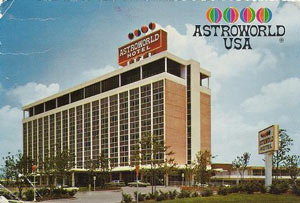 Craig Hlavaty digs into some ‘Dome history this week on the anniversary of the so-called Battle of the Sexes: the 1973 tennis match in which then-50-year-old Bobby Riggs tried and failed to “put [29-year-old] Billie Jean King and all the other Women’s Libbers back where they belong – in the kitchen and the bedroom,†as he reportedly promised in a deliberately hype-provoking pre-match interview. Hlavaty writes that the event (still the most-watched match in tennis teevee history) belongs on the roster of epic Astrodome happenings “right next to Evel Knievel jumping 13 cars on a motorcycle, Wrestlemania X-Seven (the 17th, if you can smell what the Rock is cooking), and those 6 Elvis Presley shows.” Hlavaty also notes that Riggs stayed in the decked-out Tarzan Room at the nearby AstroWorld Hotel, complete with “actual rope swing, leopard-skin everything, green plastic jungle greenery, and green shag carpet to mimic jungle grass. You can still stay in a version of the room at the hotel, now a Crowne Plaza.” [Houston Chronicle; Astrodome coverage] Postcard of AstroWorld Hotel: arch-ive.org
Craig Hlavaty digs into some ‘Dome history this week on the anniversary of the so-called Battle of the Sexes: the 1973 tennis match in which then-50-year-old Bobby Riggs tried and failed to “put [29-year-old] Billie Jean King and all the other Women’s Libbers back where they belong – in the kitchen and the bedroom,†as he reportedly promised in a deliberately hype-provoking pre-match interview. Hlavaty writes that the event (still the most-watched match in tennis teevee history) belongs on the roster of epic Astrodome happenings “right next to Evel Knievel jumping 13 cars on a motorcycle, Wrestlemania X-Seven (the 17th, if you can smell what the Rock is cooking), and those 6 Elvis Presley shows.” Hlavaty also notes that Riggs stayed in the decked-out Tarzan Room at the nearby AstroWorld Hotel, complete with “actual rope swing, leopard-skin everything, green plastic jungle greenery, and green shag carpet to mimic jungle grass. You can still stay in a version of the room at the hotel, now a Crowne Plaza.” [Houston Chronicle; Astrodome coverage] Postcard of AstroWorld Hotel: arch-ive.org
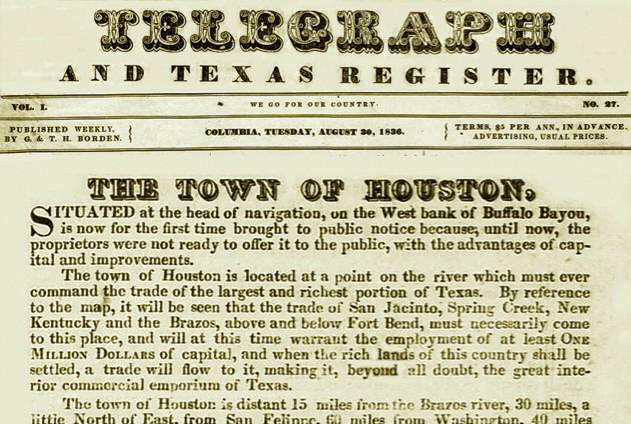
It’s that time again — Houston’s birthday celebration, observed traditionally on the anniversary of the publication of the Allen brothers’ newspaper ads offering land for sale in the area in 1836. Among the more eyebrow-worthy claims put forward by the founders: that the “beautifully-elevated” area (depicted nestled amid a clutch of towering hills) was already the site of regular steamboat traffic (the Laura wouldn’t make the first steamboat run up the sandy twists of Buffalo Bayou to Allen’s Landing until the following year), and that the area “[enjoys] the sea breeze in all its freshness” and is “well-watered” (that part, at least, is likely undisputed).
The ad text also claims that “Nature appears to have designated this place for the future seat of Government,” though Lisa Gray suggests this morning that a few well-timed gifts to members of the newly-minted Texas Legislature may have been responsible as well. Gray writes that the city hosted the Texas government from 1837 until the legislators, tired of the heat and mosquitoes, voted to move elsewhere in 1839.
Here’s the ad in its entirety, as it appeared 180 years ago today in the Telegraph and Texas Register:
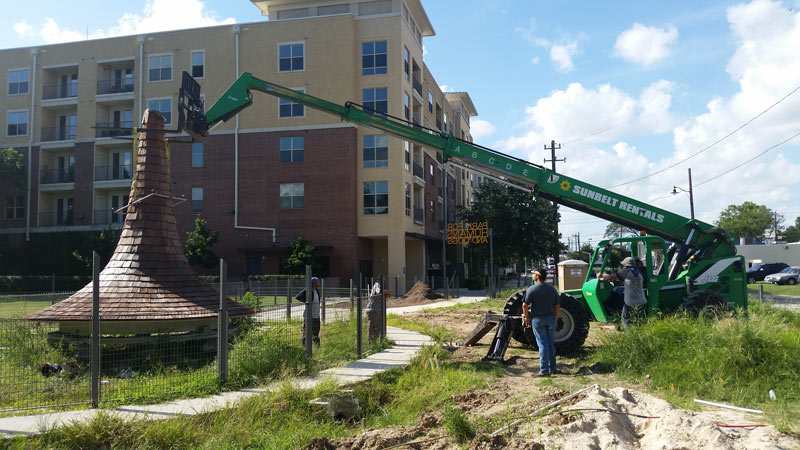
 If the top of that pointy gazebo currently camped out at the about-to-open Park for Humans and Dogs by Glenwood Cemetery looks familiar, it’s because it’s been lurking around the Houston landscape for the last 115 years or so. This morning Susie Tommaney inventories the history and internet lore surrounding the house at 2201 Fannin St., from which a cupola nicknamed the Witch’s Hat was plucked just before the home’s 1997 demolition. “Not many people realize that the cupola was saved,” TIRZ 13 chair Claude Anello tells Swamplot, sending along the photo above of the hat’s installation, as well as his account of the hat’s rediscovery, reshaping, and ground-up career-building:
If the top of that pointy gazebo currently camped out at the about-to-open Park for Humans and Dogs by Glenwood Cemetery looks familiar, it’s because it’s been lurking around the Houston landscape for the last 115 years or so. This morning Susie Tommaney inventories the history and internet lore surrounding the house at 2201 Fannin St., from which a cupola nicknamed the Witch’s Hat was plucked just before the home’s 1997 demolition. “Not many people realize that the cupola was saved,” TIRZ 13 chair Claude Anello tells Swamplot, sending along the photo above of the hat’s installation, as well as his account of the hat’s rediscovery, reshaping, and ground-up career-building:
“I got a call a few years ago from Carl Detering, who had stored it in his outdoor storage yard at Detering’s on Washington. He was selling the property and told me that someone needed to get it or he would be forced to throw it in the dumpster. When I went to look at it, it had basically melted, [and] a tree had grown up through the middle of it (removed prior to photos) . . . Several people told us that it was beyond repair, but we dismantled it, had it reconstructed, and designed the park around it. It sat on the ground for a couple of years while we dealt with issues related to park design and permitting.”
Here’s a few tree-free glamour shots of the Hat prior to those reconstructive procedures, circa late 2013:

Houston Planning Commission chief of staff Brian Crimmins announced yesterday that tomorrow will be the day a proposed name change of Dowling St. is announced to those with property along the road. The planned timeline for a few public meetings and some comment-taking stretches over the course of the next few months, with the if-everything-goes-as-planned rededication date of the street as Emancipation Ave. set for Sunday, November 6. The proposed change would mark the second de-Dowling in Houston this year, following the shifting of Dowling Middle School’s allegiance over to Audrey H. Lawson as part of HISD’s lawsuit-inspiring Confederate expulsion.
- Previously on Swamplot:Â Downtown’s Naked Confederate Birdman Unflapped By Renamings;Â Lanier Gets to Keep Half of Its Name as HISD Expels Confederates;Â A Preview of What’s Changing at Jefferson Davis High School Other Than Its Confederate Name;Â Every School In Texas Named After a Confederate Loyalist, Mapped
Rendering of under-renovation Emancipation Park at 3018 Dowling St.: Phil Frelon
THE UT AUSTIN SEGREGATION LAWSUIT THAT MADE TSU HOUSTON’S FIRST PUBLIC UNIVERSITY 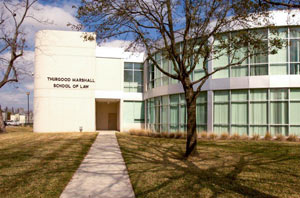 A recounting of some Houston higher-ed history comes from Ben Werlund this past weekend — namely, how University of Houston and Texas Southern University ended up as separate but adjacent public universities in the Third Ward. In 1927 the schools were founded as Houston Junior College and Houston Colored Junior College, segregated schools that eventually wound up on neighboring land after being renamed University of Houston and the Houston College for Negroes. In 1946, black Houstonian Heman Marion Sweatt was denied admission to all-white UT Austin’s law school; as the resulting lawsuit worked its way up to the Supreme Court in the pre-Brown v. Board of Education landscape of separate-but-equal requirements, the state quickly bought and renamed the Houston College for Negroes and added a law school, trying to prove that black students had comparable options to the Austin campus. “And thus, Houston’s first public university was born,” writes Werlund, to keep the Texas school system “from having to integrate its flagship in Austin.” The Supreme Court, however, didn’t buy that the new Houston law offerings measured up to the nearly 70-year-old UT law program, and UT Austin had to admit Sweatt after a 1950 ruling. TSU law professor James Douglas tells Werlund that the state legislature proceeded to cut TSU’s budget by 40 percent the next year; the private all-white University of Houston didn’t start to admit black students until 1962, shortly after which it turned public. “This was in the ’60s,” notes Douglas — “In 1964, I don’t think the people in Austin really thought integration was going to stick . . . I don’t think they ever thought this whole idea of having 2 universities close to each other was ever going to be a problem.” [Houston Chronicle] Image of Thurgood Marshall School of Law at Texas Southern University: TSU
A recounting of some Houston higher-ed history comes from Ben Werlund this past weekend — namely, how University of Houston and Texas Southern University ended up as separate but adjacent public universities in the Third Ward. In 1927 the schools were founded as Houston Junior College and Houston Colored Junior College, segregated schools that eventually wound up on neighboring land after being renamed University of Houston and the Houston College for Negroes. In 1946, black Houstonian Heman Marion Sweatt was denied admission to all-white UT Austin’s law school; as the resulting lawsuit worked its way up to the Supreme Court in the pre-Brown v. Board of Education landscape of separate-but-equal requirements, the state quickly bought and renamed the Houston College for Negroes and added a law school, trying to prove that black students had comparable options to the Austin campus. “And thus, Houston’s first public university was born,” writes Werlund, to keep the Texas school system “from having to integrate its flagship in Austin.” The Supreme Court, however, didn’t buy that the new Houston law offerings measured up to the nearly 70-year-old UT law program, and UT Austin had to admit Sweatt after a 1950 ruling. TSU law professor James Douglas tells Werlund that the state legislature proceeded to cut TSU’s budget by 40 percent the next year; the private all-white University of Houston didn’t start to admit black students until 1962, shortly after which it turned public. “This was in the ’60s,” notes Douglas — “In 1964, I don’t think the people in Austin really thought integration was going to stick . . . I don’t think they ever thought this whole idea of having 2 universities close to each other was ever going to be a problem.” [Houston Chronicle] Image of Thurgood Marshall School of Law at Texas Southern University: TSU
COMMENT OF THE DAY: THE MORE HOUSTON CHANGES, THE MORE IT STAYS THE SAME  “The problem is that Houston is in a constant state of flux. The Houston you know at 20 is unrecognizable at 50, no matter what year you were born. There is no classically recognizable Houston or Houstonian — the only thing most Houstonians share as a character trait is a mutual lack of interest in the past. When I wrote a novella about Houston, I made it ground zero of a global amnesia plague. Seemed appropriate.” [AMP, commenting on Novel Approaches to Houston] Illustration: Lulu
“The problem is that Houston is in a constant state of flux. The Houston you know at 20 is unrecognizable at 50, no matter what year you were born. There is no classically recognizable Houston or Houstonian — the only thing most Houstonians share as a character trait is a mutual lack of interest in the past. When I wrote a novella about Houston, I made it ground zero of a global amnesia plague. Seemed appropriate.” [AMP, commenting on Novel Approaches to Houston] Illustration: Lulu

Have you seen this video (at top) from the city’s planning and development department? It’s silent, several years old, and not the flashiest portrait of Houston available on YouTube. But in a compelling series of images, it shows how mightily the city’s official boundaries have grown — simply by tracking Houston’s annexation history, decade by decade.
But now there’s a more active way to appreciate Houston’s historically bulging waistline — one that could even help increase your own in the process (depending on your choice of beverages). Each of the 5 laser-cut acrylic coasters in Data Design Co.‘s limited-edition set (shown in the photo above) is etched with an outline of this ever-expanding city at some point in its history. Designers Brian Barr and Matthew Wettergreen had the sets manufactured in Houston by Post-Studio, and are now offering them for sale for $60. Buy a set, and try one beverage on each over the course of an evening of thirst-quenching, and you’ll allow yourself to drink in a progressive view of this city’s expansive growth.
COMMENT OF THE DAY: HOUSTON HEIGHTS HISTORY IN THE MAKING 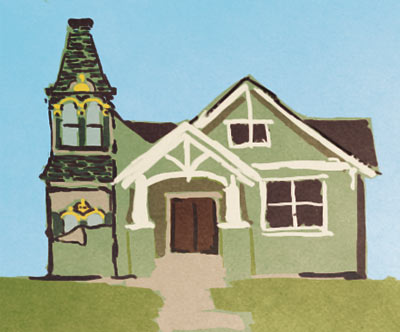 “. . . They probably looked around and saw hundreds of 3k-plus-sq.-ft. Faux Craftsman, Faux Victorian, Faux Colonial, Faux Historic, etc. ‘bungalows,’ that have replaced (or bastardized) most of the real Craftsman, Victorian, Colonial, historic bungalows and realized that the Heights ‘style’ is all fake anyway, so why bother replicating more Faux? They instead designed a building that represents its own era, 2016. . . . Don’t fret, in 100 years, this will be ‘historic’ too.” [John M, commenting on Once Bashful Heights Post Office Replacement Retail Now Willing To Step Up to the Street, Learn To Like Sidewalks] Illustration: Lulu
“. . . They probably looked around and saw hundreds of 3k-plus-sq.-ft. Faux Craftsman, Faux Victorian, Faux Colonial, Faux Historic, etc. ‘bungalows,’ that have replaced (or bastardized) most of the real Craftsman, Victorian, Colonial, historic bungalows and realized that the Heights ‘style’ is all fake anyway, so why bother replicating more Faux? They instead designed a building that represents its own era, 2016. . . . Don’t fret, in 100 years, this will be ‘historic’ too.” [John M, commenting on Once Bashful Heights Post Office Replacement Retail Now Willing To Step Up to the Street, Learn To Like Sidewalks] Illustration: Lulu
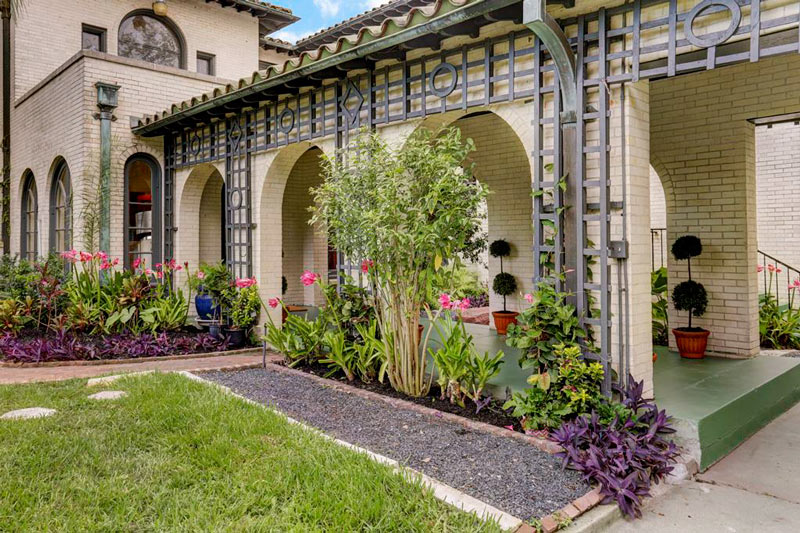

Per historian Steven Fox’s telling, the 1933 home at what’s now 2330 N. Braeswood Blvd. is the work of architect Joseph Finger (a few years after the Lancaster Hotel was built, and a few years before Finger went on to design City Hall). The 4-bedroom house sits on 1.13 acres and was the first one built along Braeswood Ct. (which loops off of N. Braeswood just west of S. Main St.). The exterior railings shown above are copper, and the enthusiastically tropical painted tile mural on the chimney reportedly dates back to the 1930s as well.
The Old Braeswood Property Owners Association traces the house’s Houston-history-heavy ownership record in a 2013 newsletter; the article follows the trail from a mysterious associate of Spindletop oilman T.P. Lee, to friends of future Texas governor Ross Sterling, to the son of Meyerland namesake Frank Meyer and beyond.
Want to add your name to the list? The current asking price is $2.6 million. Look around below:

